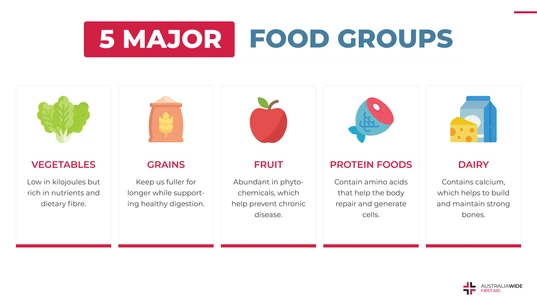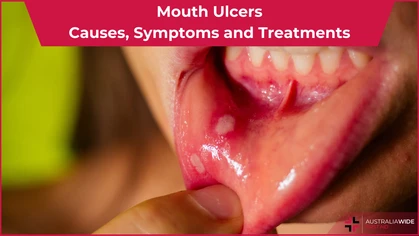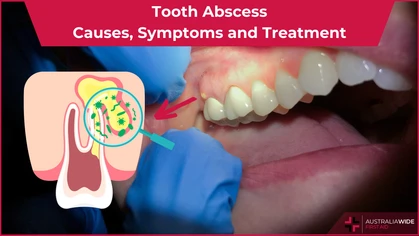Australian Guide to Healthy Eating

General Health-Related

The Australian Guide to Healthy Eating is a visual representation of the Australian Dietary Guidelines. Using this guide to inform your daily eating habits can help support your wellbeing and reduce your risk of chronic diseases.
Maintaining healthy and nutritious eating habits is crucial for supporting a long and healthy life. However, the kind of foods and various nutrients needed to be healthy can be complicated without any given guidance. In this article, we’ll be going through the Australian Guide to Healthy Eating and how you can fill your diet with nutritious foods essential to your health and well-being.What Is the Australian Guide to Healthy Eating?
The Australian Guide to Healthy Eating is essentially a food selection guide that represents the five major food groups recommended for consumption each day. The guide serves as a visual representation of the Australian Dietary Guidelines that recommended proportions and types of foods that are essential in maintaining a healthy body. In varying your diet by including a wide range of food groups, this will help reduce your risk of chronic health problems such as heart disease, diabetes, certain types of cancers and obesity. As your body operates almost seamlessly in the background, it is our job as its caretaker to fuel it with the necessary nutrients needed for everyday functions. In feeding your body, the types of food that you consume have a role to play in each bodily function. Let’s look at the types of food you can include in your diet to help your body perform to the best of its ability.Dietary Guidelines and Your Overall Health
In following the Australian Dietary Guidelines, there are essentially five principal recommendations crucial to good health outcomes. These guidelines are not strict rules that everyone needs to follow. Instead, they are described as the best approach to eating and the way we view our diets for a long and healthy life. Depending on your usual diet, these guidelines are instead meant to be integrated into what you think suits your current lifestyle. These guidelines primarily aim to promote health and wellbeing and reduce the risk of diet-related conditions and other chronic diseases that may be aggravated due to an unbalanced diet. The five principal recommendations are outlined as below:- To achieve and maintain a healthy weight, be physically active and choose amounts of nutritious food and drinks to meet your energy needs.
- Enjoy a wide variety of nutritious foods from these five groups every day: Vegetables; fruits; grains, high fibre cereals; lean meats, poultry, eggs, tofu, seeds; milk, yoghurt, cheese, or their alternatives.
- Limit intake of foods containing saturated fat, added salt, added sugars, and alcohol.
- Encourage, support, and promote breastfeeding.
- Care for your food; prepare and store it safely.
Eating Healthy in Alignment with the Australian Dietary Guidelines
Aligning your usual diet with the guidelines provided above will help ensure the maintenance of your overall well-being. The recommended servings outlined are to be consumed throughout the course of a day – not in a single meal. The five major food groups as outlined in the Australian Guide to Healthy Eating include:- Vegetables and legumes or beans – at least 5 serves per day
- Grains, cereals, and high-fibre varieties – 4 to 6 serves per day
- Fruit – 2 serves per day
- Lean meats, poultry, fish, eggs, tofu, seeds, and nuts – 2.5 to 3 serves per day
- Dairy, yoghurt, and other alternatives – 2.5 to 4 serves a day
How Do These Food Groups Contribute to My Health?
With these five major food groups, you’ll be providing your body with all the nutrients needed to fuel your everyday activities. But how do each of these food groups contribute to your overall wellbeing?Vegetables and Legumes or Beans
Munching on your leafy greens is an excellent way to get your daily vitamins, minerals, and dietary fibre that can only be found in plants. These can also help your body keep healthy by helping food pass through your digestive system.Grains, cereals, and high-fibre varieties
Bread and cereals are an excellent source of fibre, carbohydrates, protein, vitamins, and minerals. These should form the largest bulk of your diet as they provide the most energy (kilojoules) to keep you going throughout the day.Fruit
There are many varieties of fruit to choose from that provide your body with vitamins, minerals, and dietary fibre that protect your body against developing chronic diseases. Heart disease, diabetes, and some types of cancer are just some examples.Lean meats, poultry, fish, eggs, tofu, seeds, and nuts
These protein-rich foods are important to eat everyday as they help build, maintain, and repair the muscle tissue in our body. These help in maintaining muscle and organ functions as they are primarily made of protein.Dairy, yoghurt, and other alternatives
These foods are excellent sources of calcium as they are needed to maintain strong and healthy bones. They also are a good source of other nutrients such as protein, iodine, riboflavin and vitamin B12 that cannot be produced by our own body or are hard to find in other food groups.
Alcohol is listed as a discretionary food on the Australian Guide to Healthy Eating. Discretionary foods are high in kilojoules, low in essential nutrients, and can increase the risk of obesity and other chronic diseases.
The Dangers of ‘Discretionary Foods’
While we’ve listed and thoroughly gone through the foods that are important to your daily diet, there are also a list of ‘discretionary foods’ that do more harm than good for your body. ‘Discretionary foods’ are essentially foods which are not essential for our health and are typically high in added sugars, fat and alcohol. These foods contribute an excessive amount of energy into our diet by displacing nutritious foods and can cause our bodies to be nutrient deficient. Examples of ‘discretionary foods’ include:- Sweet drinks such as energy drinks, fruit drinks, soft drinks, and cordials
- Sweet pastries such as cookies, cakes and doughnuts
- Savoury foods such as pizza, meat pies and potato chips
- Processed meats such as bacon and ham
Final Thoughts
Eating a wide variety of nutritious foods is more than doable by following the Australian Guide to Healthy Eating and the Australian Healthy Eating Guidelines. These recommendations are made to suit your current lifestyle with few dietary changes that may disrupt your usual routine. Consulting these guidelines and taking advice from your trusted doctor is more than enough to ensure your body receives all the nutrients it needs to function on a daily basis.
Originally published at
https://www.australiawidefirstaid.com.au/resources/australian-guide-to-healthy-eating
as part of the Australia Wide First Aid Articles Library









